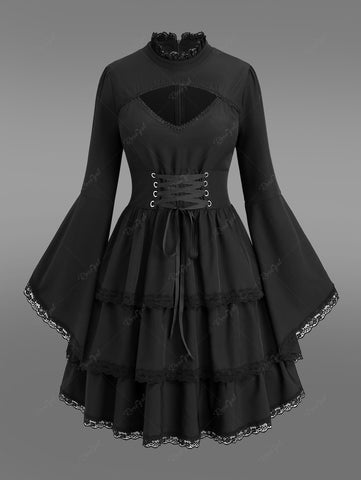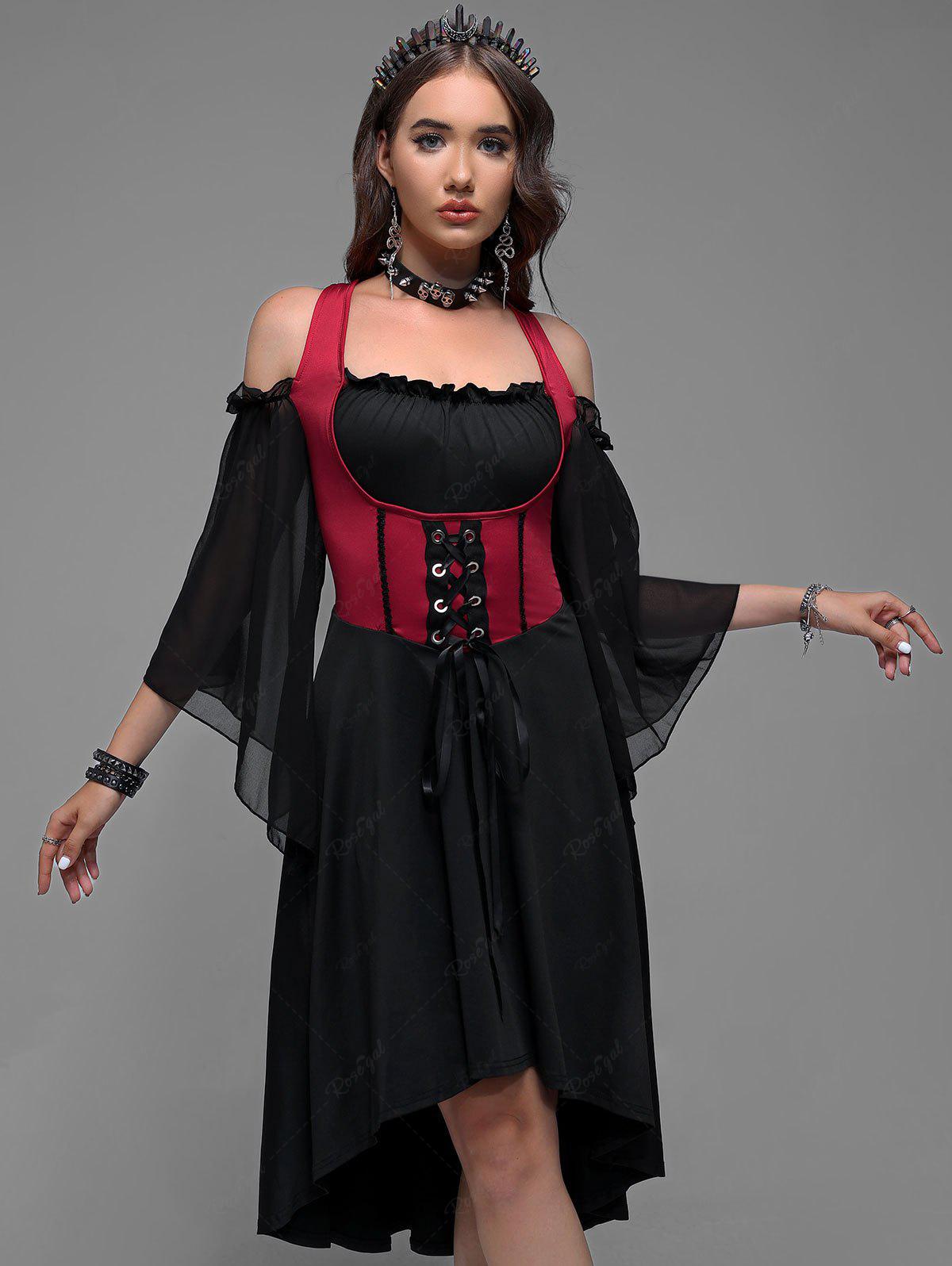
Exploring the Characteristics of Gothic Fashion
Gothic fashion is a captivating and unique style that combines elements from the modern Gothic subculture and the Victorian era. It is characterized by its somber and striking appearance, creating a dramatic and enigmatic look for the wearer.
One of the key features of Gothic fashion is the use of dark colors and shades. Black, deep red, green, violet, and blue are commonly seen in Gothic dresses, reflecting the essence of the Gothic subculture and adding to the mysterious allure of the style.
Lace is another prominent element in Gothic dresses. It is often used for sleeves, collars, or to create elaborate designs and accessories such as chokers or hats. The delicate and intricate nature of lace adds a touch of elegance and sophistication to Gothic fashion.
High necklines are a signature characteristic of beautiful Gothic dresses. These necklines, typically straight or pointed, are often made from luxurious materials like velvet or lace and adorned with intricate details like beadwork or ruffles. They not only enhance the overall aesthetic of the dress but also add a sense of refinement and elegance.
Corsets are a popular detail in Gothic dresses as they help create a sleek and curvaceous figure. Made from dark leather or velvet and adorned with lace, Gothic corsets add a touch of sensuality and allure to the overall look.
Bell-like sleeves are another typical feature of Gothic dresses. Made from flowing fabrics like chiffon, these sleeves create a striking effect when paired with a corset, adding a sense of ethereal beauty to the ensemble.
Lastly, Gothic dresses often feature long skirts, which give the wearer a graceful and elegant appearance. While traditional Gothic dresses have long skirts, modern interpretations may incorporate shorter skirts in the front with longer "tails" at the back, creating a unique and eye-catching silhouette.
In summary, Gothic fashion is characterized by its dark colors, intricate lace, high necklines, corsets, bell-like sleeves, and long skirts. These elements combine to create a captivating and elegant style that is both timeless and alluring.
The Allure of Dark Colors and Shades
When it comes to gothic fashion, one cannot deny the allure of dark colors and shades. These rich and deep hues are the epitome of gothic elegance, creating a sense of mystery and sophistication. Black, deep red, green, violet, and blue are the staple colors of gothic dresses, representing the essence of the gothic subculture.
The use of these dark shades in gothic dresses serves to create a dramatic and enigmatic appearance for the wearer. The deep black exudes an air of mystique, while the deep red symbolizes passion and intensity. Green and violet evoke a sense of enchantment and otherworldliness, while blue represents tranquility and serenity amidst the darkness.
These dark colors are not only visually striking but also symbolize the gothic aesthetic and its connection to the macabre and supernatural. They allow individuals to express their inner darkness and embrace the beauty found within the shadows.
In gothic fashion, the choice of color is crucial in creating a cohesive and captivating look. It sets the tone for the entire ensemble, complementing the intricate details and designs of gothic dresses. Whether it's a full-length gown or a shorter dress with a "tail," the dark colors and shades add depth and dimension to the overall appearance.
So, if you're drawn to the allure of dark colors and shades, embrace the gothic fashion and indulge in the elegance it offers. Let the darkness speak volumes about your style and personality, as you adorn yourself in gothic dresses that capture the essence of this captivating subculture.
The Intricate Beauty of Lace
When it comes to Gothic fashion, one cannot ignore the allure of lace. This delicate and intricate fabric adds a touch of elegance and mystery to Gothic dresses. Lace is commonly used in Gothic dresses for sleeves, collars, or to create elaborate designs and accessories like chokers or hats. Its intricate patterns and delicate texture perfectly complement the somber and striking appearance of Gothic dresses.
Lace has been a staple in Gothic fashion for centuries, with its origins dating back to the Victorian era. It adds a touch of femininity and romance to the dark aesthetic of Gothic dresses. The use of lace in Gothic fashion allows for a play of light and shadow, creating a visually captivating effect.
Gothic dresses often feature lace in unique and creative ways. From intricate lace sleeves that cascade down the arms to lace collars that frame the face, lace adds a touch of ethereal beauty to these dresses. The combination of lace with other elements like velvet or leather further enhances the Gothic aesthetic, creating a juxtaposition of softness and darkness.
In addition to its aesthetic appeal, lace also adds a tactile element to Gothic dresses. The delicate texture of lace against the skin adds a sensual and luxurious feel to the overall look. It is a fabric that demands attention and invites touch.
Overall, lace plays a vital role in the intricate beauty of Gothic dresses. Its delicate patterns, ethereal quality, and tactile appeal make it an essential element in creating the striking and enigmatic appearance that defines Gothic fashion. So, whether it's used for sleeves, collars, or as elaborate designs, lace adds a touch of elegance and allure to Gothic dresses, making them truly unique and captivating.
The Graceful High Necklines
When it comes to gothic fashion, high necklines are an essential element that adds a touch of elegance and mystery to gothic dresses. These necklines, often crafted from luxurious materials such as velvet or lace, create a striking silhouette that captures attention.
The high necklines in gothic dresses can take various forms, from straight and pointed to intricately adorned with beadwork or ruffles. These details not only enhance the overall aesthetic but also add depth and texture to the dress.
One of the reasons high necklines are favored in gothic fashion is their ability to exude a sense of sophistication and refinement. They create a regal and aristocratic look, reminiscent of the Victorian era, which is a significant influence in gothic style.
Moreover, high necklines offer a practical advantage by providing coverage and protection against the elements. They shield the wearer's neck from cold winds and add an extra layer of warmth during chilly evenings.
To further enhance the allure of high necklines, designers often incorporate intricate lacework or velvet accents. These details not only add a touch of luxury but also create a visually captivating contrast against the dark colors typically associated with gothic fashion.
In summary, high necklines are a defining characteristic of gothic dresses. They contribute to the overall elegance and sophistication of the outfit while adding a sense of mystery and allure. Whether adorned with lace or crafted from velvet, these necklines create a captivating silhouette that sets gothic fashion apart from other styles.
Sculpting the Figure with Corsets
When it comes to Gothic fashion, one cannot overlook the allure of corsets. These timeless pieces not only add a touch of elegance to Gothic dresses but also help to sculpt the wearer's figure, creating a sleek and curvaceous silhouette.
Gothic corsets are typically crafted from dark leather or velvet, adding to the overall mystique of the outfit. The intricate lace detailing on these corsets further enhances their beauty and adds a touch of femininity. Whether adorned with delicate floral patterns or intricate designs, the lace on Gothic corsets adds a touch of romance and sophistication.
The purpose of the corset is not only to accentuate the waistline but also to create an hourglass figure. By cinching in the waist and lifting the bust, corsets help to create a more defined and feminine shape. This not only adds to the overall aesthetic appeal of Gothic dresses but also boosts the wearer's confidence and self-assurance.
In addition to their figure-sculpting qualities, corsets also contribute to the overall Gothic aesthetic. Their dark and mysterious allure perfectly complements the somber and striking appearance of Gothic dresses. Whether paired with a long flowing skirt or a shorter dress with a "tail," corsets add an element of drama and intrigue to any Gothic outfit.
So, if you're looking to embrace the Gothic style and create a striking and enigmatic appearance, don't forget to incorporate a Gothic corset into your wardrobe. With its ability to sculpt the figure and add a touch of elegance, the corset is an essential element of Gothic fashion.
The Ethereal Bell Sleeves
When it comes to gothic fashion, the ethereal bell sleeves are a characteristic that adds an enchanting touch to gothic dresses. These sleeves, typically made from chiffon or similar fabrics, create a striking effect when paired with a corset. The flowing nature of the sleeves adds a sense of movement and grace to the overall look.
Gothic dresses with bell sleeves evoke a sense of mystery and romance. They harken back to the Victorian era, a time of elegance and sophistication. The billowing sleeves create a dramatic silhouette, enhancing the wearer's presence and commanding attention.
Designers often incorporate intricate details into the bell sleeves, such as lace trim or embroidery, adding to the overall allure of the dress. The combination of the flowing fabric and delicate embellishments creates a captivating visual contrast.
These sleeves not only enhance the aesthetic appeal of gothic dresses but also serve a practical purpose. The loose fit allows for ease of movement, ensuring that the wearer can navigate their surroundings with grace and ease.
Whether paired with a long skirt for a more traditional gothic look or with a shorter dress for a modern twist, the ethereal bell sleeves add a touch of elegance and drama to any gothic outfit. They are a testament to the versatility and creativity of gothic fashion, allowing individuals to express their unique style while embracing the dark and mysterious allure of the gothic subculture.
The Timeless Appeal of Long Skirts
When it comes to Gothic fashion, one cannot overlook the timeless appeal of long skirts. These flowing garments not only add grace and elegance to a Gothic dress but also embody the essence of the Gothic subculture.
Long skirts in Gothic dresses create a sense of mystery and allure, as they drape gracefully around the wearer's legs, accentuating their movements with every step. Whether crafted from luxurious velvet, delicate lace, or other high-quality materials, these skirts add a touch of sophistication to any outfit.
The length of the skirt plays a crucial role in defining the overall aesthetic of a Gothic dress. While traditional Gothic dresses often feature floor-length skirts, modern interpretations may incorporate shorter skirts in the front with a longer "tail" at the back, creating a unique and eye-catching silhouette.
In addition to their aesthetic appeal, long skirts in Gothic dresses also offer practical benefits. They provide coverage and modesty, allowing individuals to feel comfortable and confident while embracing their Gothic style. Moreover, the flowing nature of these skirts adds movement and drama to the overall look, making a bold statement wherever they go.
To fully embrace the timeless appeal of long skirts in Gothic fashion, individuals can experiment with different textures, patterns, and embellishments. From intricate embroidery to cascading layers of fabric, these details add depth and visual interest to the skirts, further enhancing their allure.
In conclusion, long skirts are an integral part of Gothic dresses, embodying the elegance and allure of the Gothic subculture. With their timeless appeal and versatility, these skirts add a touch of drama and sophistication to any Gothic outfit. Whether adorned with lace, velvet, or other luxurious materials, long skirts are a must-have for anyone seeking to embrace the dark elegance of Gothic fashion.







